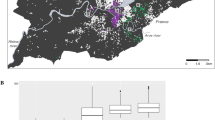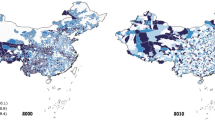Abstract
Initiated in 1995, Taiwan’s National Health Insurance (NHI) programme now covers over 99.6% of its residents, ensuring widespread medical access. Despite this, regional disparities in medical resource allocation persist. This study investigates the potential urban–rural divide in life expectancy and healthcare utilisation. Drawing data from the Ministry of the Interior (population registration records), NHI Research Database (medical utilisation) and Ministry of Health and Welfare (leading causes of death), we employ spatial analysis, visualisation tools and the standardised mortality ratio for assessing regional disparities. Our findings reveal distinct regional mortality differences in Taiwan, with lower rates in northern counties and higher ones in mountainous regions. However, healthcare utilisation shows no significant regional variations. Notably, patterns of overall mortality rates and primary death causes demonstrate spatial clustering.













Similar content being viewed by others
Data availability
The leading causes of death data can be accessed on the Taiwan Open Government Data website at https://data.gov.tw/datasets/search?p=1&size=10&s=_score_desc&rtt=1004. However, data on medical utilization and population registration records are not publicly accessible due to confidentiality and privacy concerns.
References
Ahmad, O.B., C. Boschi-Pinto, A.D. Lopez, C.J. Murray, R. Lozano, and M. Inoue. 2001. Age standardization of rates: A new WHO standard. World Health Organization 9 (10): 1–14.
Bivand, R., W.G. Müller, and M. Reder. 2009. Power calculations for global and local Moran’s I. Computational Statistics and Data Analysis 53: 2859–2872.
Chang, S. 2012. The effect of Taiwan’s National Health Insurance on mortality of the elderly: Revisited. Health Economics 21: 1257–1270.
Fotheringham, A.S., W. Yang, and W. Kang. 2017. Multiscale Geographically Weighted Regression (MGWR). Annals of the American Association of Geographers 107 (6): 1247–1265.
Fu, W.J., P.K. Jiang, G.M. Zhou, and K.L. Zhao. 2014. Using Moran’s I and GIS to study the spatial pattern of forest litter carbon density in a subtropical region of Southeastern China. Biogeosciences 11 (8): 2401–2409.
Hsieh, C., C. Su, S. Shao, S. Sung, S. Lin, Y. Kao Yang, and E.C. Lai. 2019. Taiwan’s National Health Insurance Research Database: Past and future. Clinical Epidemiology 11: 349–358.
Hsing, A.W., and J.P.A. Ioannidis. 2015. Nationwide population science lessons from the Taiwan National Health Insurance Research Database. JAMA Internal Medicine 175 (9): 1527–1529.
Hu, L., and J. Lay. 2006. Spatial analysis of female cancers in Taiwan. Journal of Taiwan Geographic Information Science 4: 39–55.
Indrakumari, R., T. Poongodi, and S.R. Jena. 2020. Heart disease prediction using exploratory data analysis. Procedia Computer Science 173: 130–139.
Keng, S., and S. Sheu. 2013. The Effect of National Health Insurance on Mortality and the SES−Health Gradient: Evidence from the Elderly in Taiwan. Health Economics 22: 52–72.
Lee, R.D., and L.R. Carter. 1992. Modeling and forecasting US mortality. Journal of the American Statistical Association 87 (419): 659–671.
Lee, P., F. Kao, F. Liang, Y. Lee, S. Li, and T. Lu. 2021. Existing data sources in clinical epidemiology: The Taiwan National Health Insurance Laboratory Databases. Clinical Epidemiology 13: 175–181.
Leong, Y.-Y., and J.C. Yue. 2017. A modification to geographically weighted regression. International Journal of Health Geographics 16: 1.
Li, N., and R.D. Lee. 2005. Coherent mortality forecasts for a group of populations: An extension of the Lee-Carter method. Demography 42 (3): 575–594.
Milo, T. and Somech, A. 2020. Automating exploratory data analysis via machine learning: An overview. Proceedings of the 2020 ACM SIGMOD international conference on management of data, pp. 2617–2622.
Moran, P. 1950. A Test for the Serial Independence of Residuals. Biometrika 37 (1/2): 178–181.
Oden, N. 1955. Adjusting Moran’s I for population density. Statistics in Medicine 14 (1): 17–26.
Shi, H., L. Zhang, and J. Liu. 2006. A new spatial-attribute weighting function for geographically weighted regression. Canadian Journal of Forest Research 36 (4): 996–1005.
Shi, Y. 2021. Forecasting mortality rates with the adaptive spatial temporal autoregressive model. Journal of Forecasting 40 (3): 528–546.
Tango, T., and K. Takahashi. 2005. A flexibly shaped spatial scan statistic for detecting clusters. International Journal of Health Geographics 4 (1): 11.
Tukey, J.W. 1977. Exploratory data analysis. Boston: Addison-Wesley Publishing Company.
Wang, H.C., J.C. Yue, and C. Chong. 2018. Mortality models and longevity risk for small populations. Insurance: Mathematics and Economics 78: 351–359.
Wen, C.P., S.P. Tsai, and W.I. Chung. 2008. A 10-year experience with universal health insurance in Taiwan: Measuring changes in health and health disparity. Annals of Internal Medicine 148 (4): 258–267.
Yu, H., A.S. Fotheringham, Z. Li, T. Oshan, W. Kang, and L.J. Wolf. 2019. Inference in multiscale geographically weighted regression. Geographical Analysis 52: 87–106.
Yue, J.C., H. Wang, Y. Liang, and W. Su. 2018. Using Taiwan National Health Insurance Database to model cancer incidence and mortality rates. Insurance: Mathematics and Economics 78: 318–324.
Yue, J.C., H. Wang, and T. Wang. 2021. Using graduation to modify the estimation of Lee-Carter model for small populations. North American Actuarial Journal 25 (sup1): S410–S420.
Author information
Authors and Affiliations
Corresponding author
Additional information
Publisher's Note
Springer Nature remains neutral with regard to jurisdictional claims in published maps and institutional affiliations.
Rights and permissions
Springer Nature or its licensor (e.g. a society or other partner) holds exclusive rights to this article under a publishing agreement with the author(s) or other rightsholder(s); author self-archiving of the accepted manuscript version of this article is solely governed by the terms of such publishing agreement and applicable law.
About this article
Cite this article
Yue, J.C., Tu, MH. & Leong, YY. A spatial analysis of the health and longevity of Taiwanese people. Geneva Pap Risk Insur Issues Pract (2024). https://doi.org/10.1057/s41288-024-00322-3
Accepted:
Published:
DOI: https://doi.org/10.1057/s41288-024-00322-3




